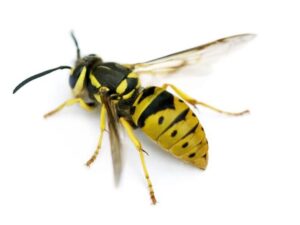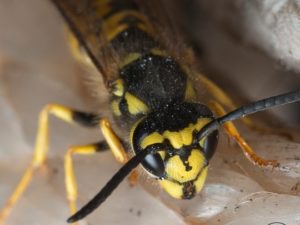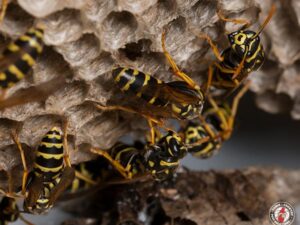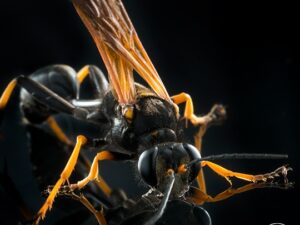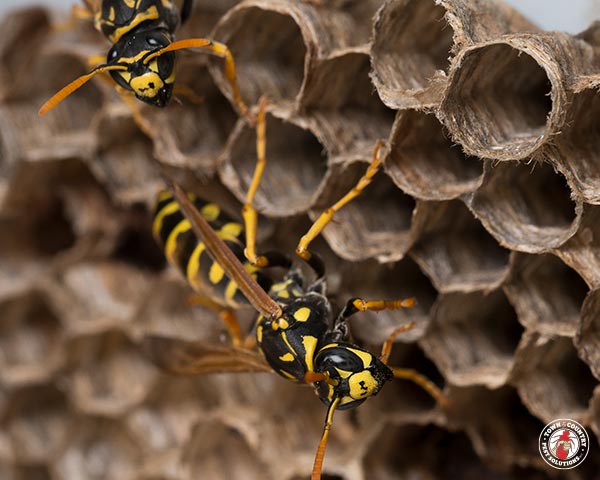
Barbecues, pool parties, and outdoor adventures—but it also brings wasps. These aggressive insects can turn a peaceful afternoon into a nightmare, especially when they build nests near your home. At Town and Country Pest Solutions, we’ve helped thousands of homeowners across Rochester, Buffalo, and Syracuse deal with wasp problems for over 30 years. Here’s what we’ve learned about keeping these stinging pests away from your property.
Wasps are more than just a nuisance. Unlike bees, they can sting multiple times and become increasingly aggressive when they feel threatened. Yellow jackets, paper wasps, and bald-faced hornets are common in New York, and each species presents unique challenges. The good news? With the right prevention strategies, you can significantly reduce your chances of dealing with a wasp infestation.
Understanding wasp behavior is key to effective prevention. These insects are attracted to specific conditions around your home, and by eliminating these attractants, you can make your property less appealing to them. Let’s explore proven methods to keep wasps at bay.
Understanding What Attracts Wasps to Your Property
Wasps don’t randomly choose where to build their nests. They’re drawn to areas that provide food sources, water, and suitable nesting sites. Recognizing these attractants is your first step toward effective prevention.
Food sources top the list of wasp magnets. Sweet substances like fruit juice, soda spills, and garbage containing food scraps create an irresistible buffet. Protein sources also attract wasps, particularly during late summer when they’re feeding their larvae. This includes pet food left outside, grease from barbecues, and even insects that wasps hunt.
Water sources provide another draw. Leaky outdoor faucets, birdbaths, swimming pools, and even morning dew on plants can attract thirsty wasps. They need water not just for drinking but also for building their paper-like nests.
Shelter opportunities complete the trifecta of wasp attractants. These insects seek protected areas to build their colonies, including eaves, wall voids, tree branches, and even playground equipment. They prefer locations that offer protection from weather while remaining accessible for foraging flights.
Essential Wasp Prevention Strategies
Remove Food and Water Sources
Start your wasp prevention efforts by eliminating easy food sources around your property. Clean up fallen fruit from trees immediately, as rotting fruit produces the sweet scents that wasps find irresistible. Store garbage in tightly sealed containers and clean them regularly to remove residual odors.
Keep outdoor eating areas clean during and after use. Wipe down picnic tables, grills, and outdoor furniture. Don’t leave pet food outside for extended periods, and clean pet bowls after each use. When hosting outdoor gatherings, cover food and drinks when not in use, and clean up spills immediately.
Address water sources by fixing leaky faucets and hoses promptly. If you have a swimming pool, maintain proper chlorination levels and keep the area clean. Consider relocating birdbaths away from high-traffic areas around your home, or refresh the water frequently to prevent stagnation.
Seal Potential Nesting Sites
Conduct a thorough inspection of your property to identify potential nesting locations. Pay special attention to eaves, soffits, and gaps in siding where wasps commonly build nests. Seal these openings with caulk or expandable foam, but only after confirming no wasps are already present.
Check playground equipment, outdoor furniture, and decorative items for hollow spaces that could house nests. Store these items in closed sheds or garages when possible, especially during peak wasp season from late spring through early fall.
Trim vegetation regularly, particularly bushes and trees near your home’s foundation. Overgrown plants provide excellent nesting sites and cover for wasp colonies. Maintain at least three feet of clearance between vegetation and your home’s exterior walls.
Natural Deterrents That Work
Several natural methods can help deter wasps without using harsh chemicals. Essential oils, particularly peppermint, eucalyptus, and lemongrass, create scents that wasps avoid. Mix these oils with water in a spray bottle and apply around potential nesting areas monthly throughout wasp season.
Decoy nests can be surprisingly effective. Wasps are territorial and typically won’t build nests near existing colonies. Hang brown paper bags shaped like wasp nests in areas where you’ve had problems before. While not 100% effective, many homeowners report success with this simple deterrent.
Planting wasp-repelling herbs around your outdoor living spaces provides both natural beauty and pest control benefits. Mint, basil, and marigolds naturally repel wasps while adding pleasant aromas to your garden. Position these plants near patios, decks, and outdoor dining areas for maximum effect.
Professional Prevention Barriers
While DIY methods help, professional prevention treatments offer more comprehensive protection. At Town and Country Pest Solutions, our Stinging Insect Program includes exterior prevention barriers applied before wasp season begins. These treatments create a protective zone around your home that deters wasps from nesting nearby.
Professional treatments target areas where homeowners typically can’t reach safely, such as high eaves and roof lines. We use specialized equipment and products that provide longer-lasting protection than consumer-grade options. Our technicians also identify potential problem areas that untrained eyes might miss.
The timing of professional treatments is crucial. Early spring applications, before wasps become active, provide the best results. This proactive approach prevents colonies from establishing rather than trying to eliminate them after they’re already built.
What to Do If Prevention Fails
Despite your best efforts, you might still encounter wasps around your property. Never attempt to remove active nests yourself—this is extremely dangerous and often makes the problem worse. Wasps release alarm pheromones when threatened, which can trigger aggressive behavior from the entire colony.
If you spot a nest, keep your distance and contact professional pest control services immediately. At Town and Country Pest Solutions, we handle emergency “nest break-in” calls as part of our stinging insect program. Our technicians have the proper equipment and expertise to safely remove nests and treat the area to prevent re-infestation.
Monitor your property regularly throughout wasp season. Early detection of new nests makes removal easier and safer. Look for increased wasp activity in specific areas, as this often indicates a nearby nest. Paper wasps build umbrella-shaped nests under eaves, while yellow jackets often nest in wall voids or underground.
Seasonal Prevention Timeline
Effective wasp prevention follows a seasonal schedule. Begin preparations in early spring, typically March in New York, when queens emerge from winter hibernation and scout for nesting sites. This is when prevention barriers are most effective.
Continue monitoring and maintenance throughout summer months. Reapply natural deterrents monthly, keep food sources cleaned up, and watch for signs of new nests. Late summer brings peak wasp activity as colonies reach maximum size and become more aggressive.
Fall cleanup is equally important. Remove fallen fruit, clean up outdoor eating areas one final time, and seal any new gaps you’ve discovered. This preparation reduces overwintering sites for next year’s queens.
When to Call the Professionals
Some situations require professional intervention from the start. If you’ve had recurring wasp problems, multiple nests, or nests in difficult-to-reach locations, professional treatment is your safest option. Individuals with allergies to insect stings shouldn’t attempt any DIY wasp control methods.
Our Everything Package at Town and Country Pest Solutions includes comprehensive wasp prevention and treatment as part of year-round pest control coverage. This program provides two seasonal prevention barriers plus treatment of any active nests that develop throughout the season.
Your Next Steps for Wasp-Free Living
Wasp prevention requires consistent effort and the right strategies, but the peace of mind is worth it. Start with eliminating food and water sources, then seal potential nesting sites and consider natural deterrents for additional protection.
For comprehensive protection, consider professional prevention treatments before wasp season begins. At Town and Country Pest Solutions, we’ve been taking the sting out of summer for over 30 years across Rochester, Buffalo, and Syracuse. Our Stinging Insect Program provides guaranteed protection against wasps, hornets, yellow jackets, and other stinging insects.
Don’t let wasps ruin your outdoor enjoyment this year. Contact Town and Country Pest Solutions today for a free consultation and learn how our proven prevention strategies can keep your property wasp-free all season long.

